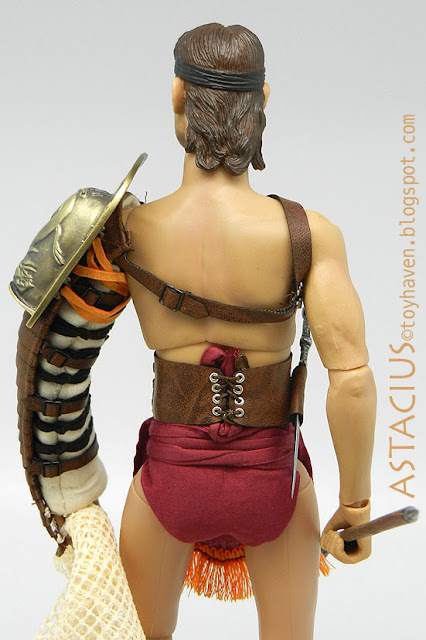After revealing the Kaustic Plastik "Astacius" basic figure and the box contents in the previous post, I now present the fully equipped Kaustic Plastik 1/6 "Astacius" Retiarius 12-inch roman gladiator figure ready for battle in the arena!
The retiarius (plural retiarii; literally, "net-man" or "net-fighter" in Latin) was a Roman gladiator who fought with equipment styled on that of a fisherman: a weighted net (rete, hence the name), a three-pointed trident (fuscina or tridens), and a dagger (pugio). The retiarius was lightly armoured, wearing an arm guard (manica) and a shoulder guard (galerus). Typically, his clothing consisted only of a loincloth (subligaculum) held in place by a wide belt, or of a short tunic with light padding. He wore no head protection or footwear.
Kaustic Plastik has done their research from the ruins of ancient Rome and brings to us this highly accurate depiction of a Retiarius roman gladiator figure as he would have been in Rome, Italy, circa 300 A.D.
This 1/6 scale Retiarius roman gladiator 12-inch figure is not lacking in any department and has on him all the trappings that would have been on the ancient historical figure :) It is beautifully produced in accurate scale with fine etchings on the die-cast bronze metal parts to achieve a very authentic look.
The net-fighter made up for his lack of protective gear by using his speed and agility to avoid his opponent's attacks and waiting for the opportunity to strike.
He first tried to throw his net over his rival. If this succeeded, he attacked with his trident while his adversary was entangled.
Another tactic was to ensnare his enemy's weapon in the net and pull it out of his grasp, leaving the opponent defenseless. Should the net miss or the secutor grab hold of it, the retiarius likely discarded the weapon, although he might try to collect it back for a second cast.
Usually, the retiarius had to rely on his trident and dagger to finish the fight.
The trident, as tall as a human being, permitted the gladiator to jab quickly and keep his distance. It was a strong weapon, capable of inflicting piercing wounds on an unprotected skull or limb.
Retiarii first appeared in the arena during the 1st century AD and had become standard attractions by the 2nd or 3rd century. The gladiator's lack of armour and his reliance on evasive tactics meant that many considered the retiarius the lowliest (and most effeminate) of an already stigmatised (i.e. gladiators) class.
Passages from the works of Juvenal, Seneca, and Suetonius suggest that those retiarii who fought in tunics may have constituted an even more demeaned subtype (retiarii tunicati) who were not viewed as legitimate retiarii fighters but as arena clowns. Nevertheless, Roman artwork, graffiti, and grave markers include examples of specific net-men who apparently had reputations as skilled combatants and lovers.
The dagger was the retiarius's final backup should the trident be lost. It was reserved for when close combat or a straight wrestling match had to settle the bout.
The more skin left unarmoured and exposed, the lower a gladiator's status and the greater his perceived effeminacy. The light arms and armour of the retiarius thus established him as the lowliest, most disgraced, and most effeminate of the gladiator types.
Helmets allowed both gladiators and spectators to dehumanise the fighters; when an arena combatant had to kill a comrade-at-arms, someone he probably lived and trained with every day, his opponent's helmet added an extra layer of separation. However, the retiarius was allowed no head protection; his face was visible to all.
The retiarius is the most readily identifiable gladiator type, due to his signature equipment: arm guard (manica), shoulder guard (galerus), net (rete), trident (fuscina or tridens), and dagger (pugio). Technically, the retiarius was not a "gladiator" at all, since he did not fight with the sword – gladius – after which such fighters took their name.
The retiarius also used a dagger with four spikes (known as a quadrens – each spike at the corner of a square guard) instead of the usual bladed dagger. The 1/6 scale version was shown in the previous post.
Although the net (rete) was this gladiator's signature weapon, few depictions of the device survive. The retiarius complemented his net with an iron or bronze trident (fuscina, fascina or, rarely, tridens) that stood about as high as a human being.
Kaustic Plastik 1/6 trident even has details like a seashell on one side and Poseidon (the god of the sea, depicted in classical artwork as a mature man of sturdy build with a dark beard, and holding a trident.) on the other. Very cool indeed :)
Archaeologists have excavated three engraved shoulder guards (galerus) from the gladiator barracks at Pompeii: one is engraved with illustrations of an anchor, a crab, and a dolphin; another with cupids and the head of Hercules; and a third with weapons and the inscription RET/SECUND ("retiarius, second rank"). See how close Kaustic Plastik based their "Astacius" Retiarius 12-inch roman gladiator figure's galerus on. It's an exact replica in 1/6 scale.
What has come before:
Kaustic Plastik 1/6 scale "Celadus" Thraex Roman gladiator 12-inch figure reviewed HERE
You can order the Kaustic Plastik 1/6 scale Celadus Thraex 12-inch Roman gladiator figure on their website HERE. Their products are also distributed in USA by Cotswold Collectibles and they are very proud of this because Cotswold Collectibles is one of the oldest company totally dedicated to Action Figures!
If you are in Singapore or around this region, you can also order through The Falcon's Hangar


















No comments:
Post a Comment